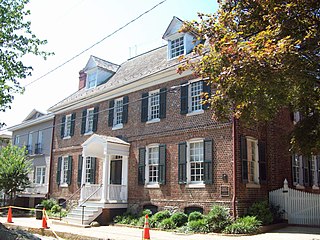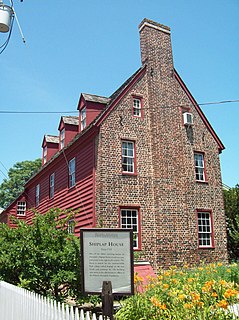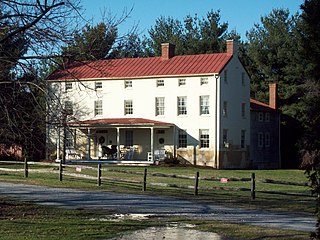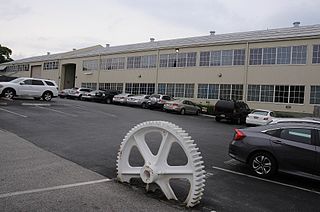
The Chase–Lloyd House is a historic house at 22 Maryland Avenue in Annapolis, Maryland. Built in 1769-1774, it is one of the first brick three-story Georgian mansions to be built in the Thirteen Colonies, and is one of the finest examples of the style. Its interiors were designed by William Buckland. Its construction was started for Samuel Chase, who would later be a signatory to the Declaration of Independence and Associate Justice of the Supreme Court, but Chase sold the building unfinished to Edward Lloyd IV in 1771. Lloyd completed the house in 1774 with assistance from Buckland and another architect, William Noke. The house remained in the Lloyd family until 1847, when it was sold to a relation of Chase. Hester Anne Chase was the daughter of Jeremiah Townley Chase who was Samuel Chase's cousin. When she died, she left the house to her 3 orphan nieces, Francis, Matilda, and Hester. In 1888 the house was bequeathed for use as a home for elderly women by the will of the last living niece, Hester. It continues in this use today. While the upper floors are off limits to visitors, the main floor and the extensive gardens are open to the public.

Whitehall is a plantation house that was built beginning in 1764 near Annapolis in Anne Arundel County in the Province of Maryland by Provincial Governor Horatio Sharpe. When Whitehall was built, Maryland was a colony of the Kingdom of Great Britain. The house is located about 7.5 miles (12.1 km) to the east of Annapolis on a peninsula between Whitehall Creek and Meredith Creek, opposite Sharpe's Point on a branch of Chesapeake Bay. The site originally comprised about 1,000 acres (400 ha). The house is a five-part Georgian mansion of great length, only one room deep in the main section. It features elaborate original interior woodwork, attributed to William Buckland, and is one of only two pre-Revolutionary houses in the Thirteen Colonies to have a temple portico. It was designated a National Historic Landmark in 1960.

The Peggy Stewart House, also known as the Rutland-Jenifer-Stone House, is a Georgian style house in Annapolis, Maryland. Built between 1761 and 1764 by Thomas Rutland as a rental property, it was owned at various times by Thomas Stone and Daniel of St. Thomas Jenifer. In October 1774 it was owned by Anthony Stewart, owner of the ship Peggy Stewart. It was listed in the National Register of Historic Places in 1973 for its associations with the burning of Anthony Stewart's ship, Peggy Stewart, as well as for its architectural significance as a mid- to late 18th century Georgian mansion. Furthermore, the dwelling was recognized as a National Historic Landmark for its associations with Jenifer and Stone, and for the thematic representation of politics and diplomacy during the American Revolution

The Colonial Annapolis Historic District is a historic district in the City of Annapolis, the state capital of Maryland, that was designated a National Historic Landmark District in 1965 and was geographically further expanded in 1984.
Aisquith Farm E Archeological Site is an archaeological site near Riva in Anne Arundel County, Maryland. It is one of several small sites located within the confines of Aisquith farm. It is associated with the Early and Middle Woodland periods of cultural development in Anne Arundel County. The site is significant as a base camp property type.
Arundel Cove Archaeological Site is an archaeological site near Baltimore in Anne Arundel County, Maryland. It is situated on the south shore of Arundel Cove, a tributary of Curtis Creek which drains into the Patapsco River. The site was discovered during routine shovel test pitting of the U.S. Coast Guard Yard at Curtis Bay in 1981. The test pits revealed that the site is small in size, extending only 20 feet north-south by 15 feet east-west. It represents the remains of a prehistoric summer camp which apparently was not repeatedly occupied. It contains a prehistoric period storage pits, with evidence of the use of galium and wild black cherry.
The Beck Northeast Site is an archaeological site near Davidsonville in Anne Arundel County, Maryland. This site was discovered in the 1930s and investigations since that time have revealed artifacts dating from the Late Archaic period through the Middle Woodland period.
The Katcef Archeological Site is an archaeological site near Crofton in Anne Arundel County, Maryland. It is a series of overlapping base camp sites dating from the Clovis phase of the Paleoindian period, through to the Late Woodland period. The primary era of site utilization was during the Late Archaic period.
The Magothy Quartzite Quarry Archeological Site is an archaeological site near Pasadena in Anne Arundel County, Maryland. The site consists of several large outcroppings of quartzite and sandstone, that may have been utilized by prehistoric Native American groups as early as the Middle Archaic period, if not earlier.

The Martins Pond Archeological Site is an archaeological site near Annapolis in Anne Arundel County, Maryland. It is a Middle-Late Woodland period site, with lithic, floral, and faunal remains.
The Elkridge Site, or Elkridge Prehistoric Village Archeological Site, is an archaeological site near Elkridge in Anne Arundel County, Maryland. It is located on a 20-foot (6.1 m) terrace above the Patapsco River and extends 1,200 feet (370 m) along the river and inland from 20–400 feet. It is the only known Woodland period riverine-oriented village site in the tidewater Patapsco River valley which has at least partially escaped the totally destructive forces of gravel quarrying. The site appears to have been abandoned as a permanent village in the early 16th century.

The Benson–Hammond House is a historic house located on Poplar Avenue in Linthicum Heights, Anne Arundel County, Maryland.

Grassland is a historic house at Annapolis Junction, Anne Arundel County, Maryland. It was built in 1853, and is a three-part brick structure constructed in a telescoping manner. Other structures on the property are the one-story frame slave house with brick-nogged walls, a small stone smokehouse, the remains of a summer kitchen, and a frame harness shed, storage shed, and the ruins of a bank barn. The outbuildings are known to have been erected between 1852 and 1854 by the plantation slaves.

Iglehart is a historic home at Iglehart, Anne Arundel County, Maryland, United States. It is a 2 1⁄2-story Greek Revival-style frame house with a gable roof, built about 1830. Its owner, Leonard Iglehart, served as a commissioner for the primary schools in Anne Arundel County from 1834 until 1838. He was also one of the six original commissioners of the Annapolis and Elk Ridge Railroad, which was incorporated by an act of the Maryland General Assembly in December 1836.

Stanton Center is a historic building at Annapolis, Anne Arundel County, Maryland, United States. It is a two-story, Classical Revival brick masonry building with a one-story addition. It is the second school building on the site and was first used as an elementary school and later became the first high school for African Americans in Anne Arundel County. It remained in use as a school until the desegregation of the Anne Arundel County school system in the 1960s, when it became a community center.

Tracy's Landing Tobacco House No. 2 is a historic tobacco barn at Tracy's Landing, Anne Arundel County, Maryland. It is a 24’3" by 45’2" heavy timber framed tobacco barn with a construction date of 1805. It is the earliest identified tobacco house extant in Anne Arundel County, and is one of the earliest recorded examples of this type of agricultural building in Tidewater Maryland.

Chance Boatyard is a group of historic buildings at Annapolis, Anne Arundel County, Maryland. It used to be a boat-building and repair complex. Most of the buildings were built between 1913 and 1942 to support the boat-building and repair activity of Chance Marine Construction Corporation and its successors, Annapolis Yacht Yards and Trumpy & Sons.

The Old City Hall and Engine House is a historic municipal building at Annapolis, Anne Arundel County, Maryland, United States. It is a 2 1⁄2-story, three bay brick building built 1821–1822 by the City of Annapolis. It was the first structure erected by the city for municipal purposes. On the first floor was the fire station, with a meeting room for the town council above. In 1868 the city sold the building for commercial purposes.

Robinson House is a historic home located at Severna Park in Anne Arundel County, Maryland, United States. It was built about 1740 and is a 1 1⁄2-story stone dwelling with a gambrel roof, 40 feet wide by 24 feet deep. It is built of red sandstone, locally known as ironstone.

















